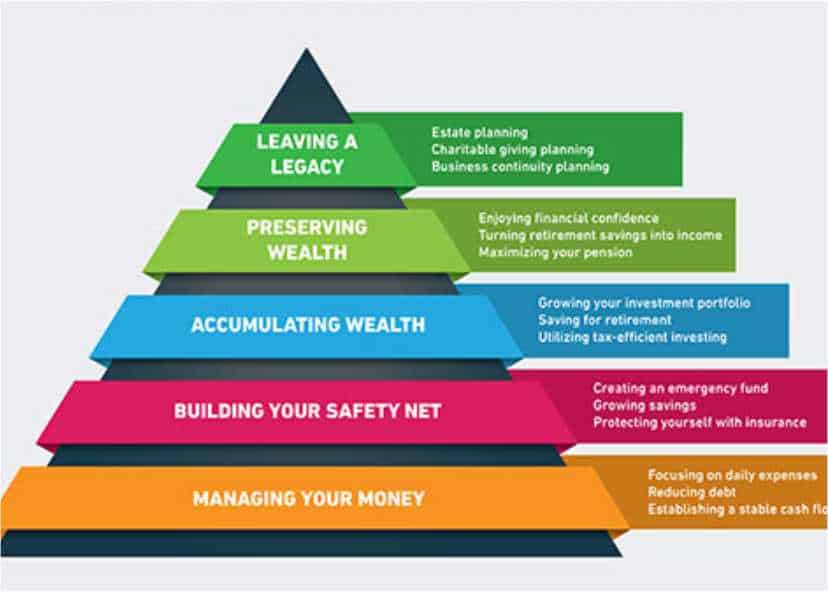Managing your finances can be overwhelming, especially if you don’t know where to start. This is where the financial pyramid comes in. The financial pyramid is a framework that can guide you through the different stages of financial management. It is divided into three levels: wealth protection, wealth accumulation, and wealth distribution.
Financial Pyramid

A financial pyramid is a representation of the different stages involved in managing one’s financial resources. It serves as a guide to help individuals achieve their financial goals and secure their future. The pyramid is divided into three levels: wealth protection, wealth accumulation, and wealth distribution.
Wealth Protection
The first level of the financial pyramid is wealth protection. This level is all about protecting your assets and ensuring that you have a safety net in case of emergencies or unexpected events. It involves establishing an emergency fund, obtaining adequate insurance coverage, and creating a will or estate plan.
An emergency fund is a savings account that you can access in case of unexpected events such as job loss, medical emergencies, or car repairs. It is recommended to have at least three to six months’ worth of living expenses in your emergency fund.
Insurance coverage is also essential to protect your assets from unforeseen events. This includes health insurance, life insurance, and property and casualty insurance. You should also review your insurance coverage periodically to ensure that it remains adequate and up-to-date.
A will or estate plan is a legal document that outlines how your assets will be distributed after your death. It is essential to have a will or estate plan to ensure that your assets are distributed according to your wishes and to avoid any disputes among your heirs.
Accumulation of Wealth (Wealth Accumulation)
The second level of the financial pyramid is wealth accumulation. This level focuses on building wealth over time through investments and savings. It involves creating a budget, setting financial goals, and investing in assets that will appreciate in value over time.
Creating a budget is the first step towards accumulating wealth. A budget helps you track your income and expenses and identify areas where you can reduce your spending and save money. It is essential to have a budget that is realistic and flexible to accommodate unexpected expenses.
Setting financial goals is another crucial step towards wealth accumulation. Financial goals can include saving for retirement, purchasing a home, or paying off debt. It is essential to set specific, measurable, and achievable goals and track your progress regularly.
Investing in assets that appreciate in value over time is also essential for wealth accumulation. These assets can include stocks, bonds, real estate, or other investments. It is important to diversify your portfolio to minimize risk and maximize returns.
Wealth Distribution
The third level of the financial pyramid is wealth distribution. This level is all about preserving and distributing your assets to your heirs or to charitable causes. It involves estate planning, tax planning, and charitable giving.
Estate planning is the process of creating a plan to distribute your assets after your death. It includes creating a will, setting up a trust, and establishing powers of attorney. Estate planning is essential to ensure that your assets are distributed according to your wishes and to minimize taxes and legal fees.
Tax planning is also essential for wealth distribution. It involves maximizing tax deductions and minimizing tax liabilities. Tax planning can include strategies such as charitable giving, retirement planning, and estate planning.
Charitable giving is a way to give back to the community and support causes that are important to you. It can also provide tax benefits by reducing your taxable income. Charitable giving can include donating money, volunteering your time, or donating assets such as stocks or real estate.
The Importance of the Financial Pyramid
The financial pyramid is an essential tool for financial management. It provides a framework for managing your finances and achieving your financial goals. By following the steps outlined in the financial pyramid, you can protect your assets, accumulate wealth over time, and distribute your assets to your heirs or to charitable causes.
Financial management is a lifelong process that requires discipline, patience, and perseverance. By following the principles of the financial pyramid, you can achieve financial security and peace of mind It is important to note that the financial pyramid is not a one-size-fits-all solution. Your financial situation and goals may require adjustments to the framework. For example, if you have significant debt, you may need to focus on debt reduction before moving on to wealth accumulation.
Another important consideration is the impact of external factors such as economic conditions and market volatility. These factors can affect your financial situation and require adjustments to your financial plan. It is important to stay informed and seek professional advice when necessary.
In addition, it is essential to develop good financial habits and behaviors to support your financial goals. This includes tracking your expenses, avoiding unnecessary debt, and investing in your education and career.
In conclusion, the financial pyramid is a useful tool for financial management. It provides a framework for protecting your assets, accumulating wealth, and distributing your assets to your heirs or to charitable causes. By following the principles of the financial pyramid and developing good financial habits, you can achieve financial security and peace of mind. Remember to stay informed, seek professional advice, and adapt your financial plan as needed.